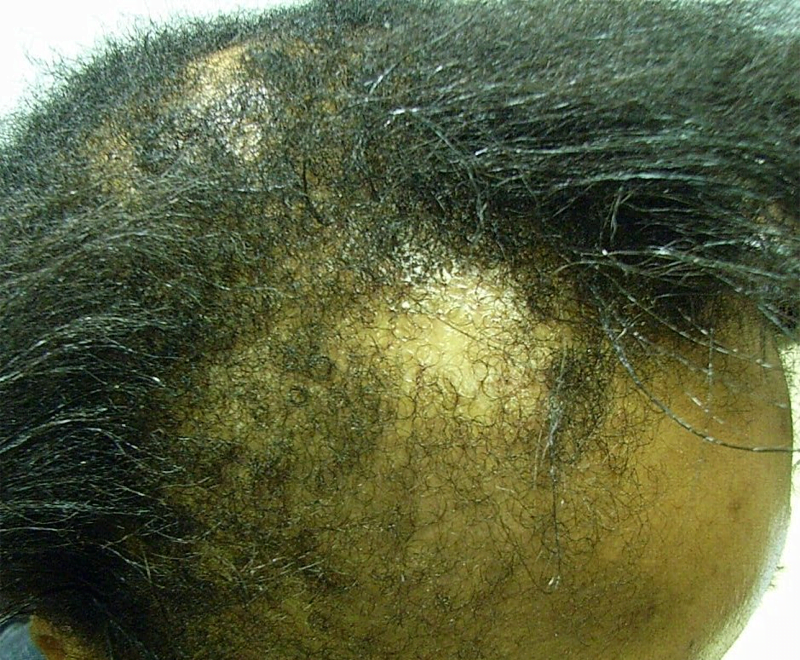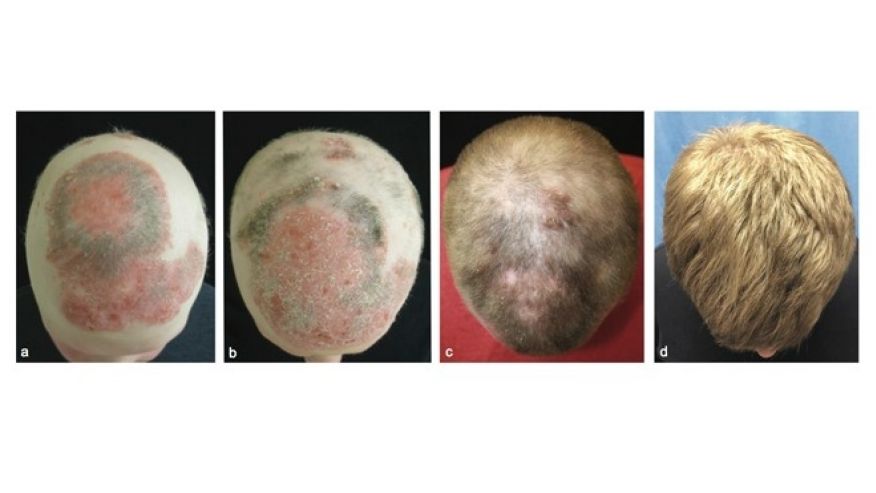
OVERVIEW
Progressive hair loss is common in both men and women. The most common type of hair loss is known as androgenetic alopecia. Other terms for androgenetic alopecia include “male pattern hair loss” and “female pattern hair loss.”
For many people, losing their hair is a frustrating experience. Fortunately, treatments are available that can help to regrow hair or prevent further hair loss.
CAUSES
The hair follicle is a structure that encases the lower part of the hair shaft (the shaft is the part you can see outside your scalp). Each follicle contains blood vessels that nurture new hair growth. All hair follicles are present at birth; throughout a person’s lifetime, each follicle grows and sheds single hairs in a repetitive cycle. The growth phase for a single new hair lasts two to three years. At the end of this time, growth ceases and the follicle enters a resting phase. After three to four months in the resting phase, the hair is shed and the next growth cycle begins.
On a normal scalp, approximately 80 to 90 percent of follicles are growing at any time. Each day, about 75 follicles shed their hair while the same number enter a new growth phase. In men with androgenetic alopecia, hormones related to testosterone (also called androgens) cause hair follicles to have a shorter-than-normal growth phase, resulting in hair shafts that are abnormally short and thin. These follicles are said to be “miniaturized.” This also happens in women with androgenetic alopecia, although it’s less well understood exactly what factors contribute to this process
Genetics — It is not fully understood why some men develop androgenetic alopecia and others do not. It is generally accepted that there is a genetic component, but the exact way in which family history affects a man’s chance of developing hair loss has not been determined.
Genetics also appear to play a role in the risk for androgenetic alopecia in women, although other factors (some of which remain unknown) may also be important. As an example, abnormal levels of androgens in the blood are the cause of androgenetic alopecia in a minority of women. Additional research is necessary to provide a better understanding of the role of genetics and other factors in androgenetic alopecia.
SYMPTOMS
In men, androgenetic alopecia is characterized by gradual hair thinning that most often affects the crown and frontal areas of the scalp (figure 1).
Hair loss in women usually affects the crown and frontal areas of the scalp. Typically, the hair loss is more diffuse than in men; women rarely develop completely bald areas (figure 1).
DIAGNOSIS
Androgenetic alopecia can usually be diagnosed by examining the scalp. In some cases, you will need blood tests or a biopsy of the scalp to look for other causes of hair loss.
PSYCHOSOCIAL IMPACT OF HAIR LOSS
Losing your hair can be frustrating and upsetting. While it’s normal and common to lose hair with age, it can still be distressing, especially as people often feel that society reinforces the message that a youthful appearance is more attractive. People with hair loss may struggle with low self-esteem or body image issues.
If you are struggling with the psychosocial impact of losing your hair, speak to a health care provider knowledgeable about the diagnosis and treatment of hair loss. Experienced providers can offer support and may recommend working with a therapist, clinical psychologist, or support group; individual and group therapy can help people adjust and cope with hair loss. Having a supportive partner, family members, or friends can also help.
Some people choose to accept their hair loss and learn to live with it, while others choose treatment (see ‘Treatment’ below). This is a personal decision.
TREATMENT
Several medications are available for the treatment of androgenetic alopecia:
●Men can be treated with minoxidil or finasteride.
●Women can be treated with minoxidil or spironolactone. Occasionally, finasteride is used in women.
Surgical options, laser light devices, and injections of platelet-rich plasma may also be considered in some cases.
All of these treatment options are discussed in more detail below.
Medications
Minoxidil — Minoxidil (brand name: Rogaine) is a medication that you apply directly to your scalp. You can buy it without a prescription. It promotes hair growth by lengthening the growth phase of hair follicles and causing more follicles to produce hair; then, the hairs that are produced tend to be larger and thicker.
Minoxidil is commercially available in a 2% and 5% liquid or 5% foam. The 5% liquid or foam is used for both men and women. The 2% foam is used for women. (See ‘Side effects’ below.)
How to use — In order to be effective, minoxidil must be applied to your scalp, not just your hair. Read the package instructions carefully so you know how much to use and how to apply it. Then lightly spread the solution over the affected area with your finger (you do not need to rub it in).
You will need to continue using minoxidil for at least four to six months in order to know if it is working. At first, you might actually notice more shedding of hair; this does not mean the medication is making your hair loss worse. This shedding usually resolves within two months, and by four to eight months, new hair begins to grow. The effects of minoxidil usually stabilize after 12 to 18 months of use.
Treatment with minoxidil must be continued indefinitely. If you stop using it, any hair that has been maintained or regrown as a result of the medication will be lost.
Side effects — Minoxidil causes few side effects. Occasionally, the skin on the scalp may become red or irritated, causing itching.
Finasteride — Finasteride (brand name: Propecia) is a prescription medication that comes as a pill. It works by decreasing the production of one of the hormones associated with androgenetic alopecia, resulting in an increased amount of hair covering more of the scalp.
Finasteride is not safe for use during pregnancy. This is because there is a risk that it could cause abnormal development of the genitalia in a male fetus. People who could be pregnant should not even come into contact with finasteride pills.
How to use — Men can take finasteride by mouth at a dose of 1 milligram (mg) per day. Higher doses are sometimes used for women.
Side effects — Higher doses of finasteride (such as those used to treat some prostate conditions) can cause side effects including erectile dysfunction and decreased sex drive in males. However, such side effects are rarely seen with the 1 mg dose used to treat hair loss in males.
Some studies have suggested that people who take finasteride might be at increased risk for suicidality or other psychologic problems like depression or anxiety. It is not clear whether the medication actually causes these problems. However, it’s important to be aware of this possibility and tell your health care provider right away if you have symptoms of depression or anxiety. If you ever feel like you might harm yourself, call for emergency medical help (in the United States and Canada, call 9-1-1) right away.
Spironolactone — Spironolactone (brand names: Aldactone, CaroSpir) is a prescription medication that comes as a pill. Like finasteride, it decreases the production of hormones that contribute to androgenetic alopecia. Women with androgenetic alopecia may benefit from the addition of spironolactone. However, spironolactone should not be used during pregnancy, so anyone who could get pregnant must use reliable birth control if they take this medication. (See “Patient education: Birth control; which method is right for me? (Beyond the Basics)”.)
Because of its effects on hormones, spironolactone is not used in men.
How to use — Spironolactone is taken as a pill. Your provider may prescribe a low dose to start with and then increase the dose over time. It may take six months or longer to know if the medication is working.
Side effects — Potential side effects of spironolactone include headache, dizziness, sleepiness, breast tenderness, and elevated potassium levels in the blood.
Surgery — For some patients, surgical treatment of hair loss may be an option. Surgical options include hair transplantation, in which healthy follicles from other parts of the scalp are transplanted to areas affected by hair loss. Scalp reduction is another procedure sometimes performed. In scalp reduction, bald patches of the scalp are removed and the remaining skin is sewn together.
Products to camouflage hair loss — While they do not treat hair loss directly, there are products that can make thinning hair less obvious. They include thickening shampoos, hair dyes, and sprays that make your scalp appear the same color as your hair. Some people also choose to wear a wig, toupee, or headpiece.
Other treatments — While some studies have suggested that low-level laser light therapy, platelet-rich plasma injections, and oral minoxidil are effective for hair loss, more research is needed to understand the best way to use these treatments and determine whether there is long-lasting benefit.
Laser light devices — Combs or other devices that deliver a type of light called “low-level laser light” to the scalp may help to grow hair in some people with androgenetic alopecia. These devices are typically used approximately three times per week for several minutes.
Platelet-rich plasma — This treatment involves removing plasma from your own blood and injecting it in your scalp. The idea is that the concentration of platelets, which are involved in wound healing, may stimulate hair growth.
Oral minoxidil — Oral minoxidil, a form of minoxidil typically used for the treatment of high blood pressure, may help with hair growth on the scalp. Oral minoxidil is usually taken once daily. Some of the potential side effects of oral minoxidil are leg swelling and increased hair growth in other areas of the body.
WHERE TO GET MORE INFORMATION
Your health care provider is the best source of information for questions and concerns related to your medical problem.
This article will be updated as needed on our web site (www.uptodate.com/patients). Related topics for patients, as well as selected articles written for health care professionals, are also available. Some of the most relevant are listed below.
Patient level information — UpToDate offers two types of patient education materials.
The Basics — The Basics patient education pieces answer the four or five key questions a patient might have about a given condition. These articles are best for patients who want a general overview and who prefer short, easy-to-read materials.
Patient education: Hair loss in men and women (The Basics)
Beyond the Basics — Beyond the Basics patient education pieces are longer, more sophisticated, and more detailed. These articles are best for patients who want in-depth information and are comfortable with some medical jargon.
Patient education: Alopecia areata (Beyond the Basics)
Professional level information — Professional level articles are designed to keep doctors and other health professionals up-to-date on the latest medical findings. These articles are thorough, long, and complex, and they contain multiple references to the research on which they are based. Professional level articles are best for people who are comfortable with a lot of medical terminology and who want to read the same materials their doctors are reading.
[“source=uptodate”]

















